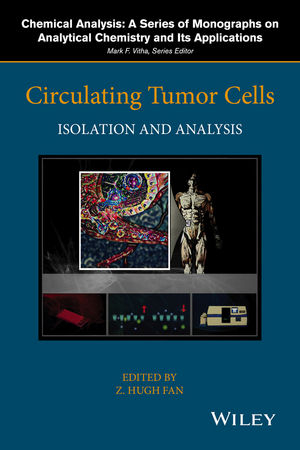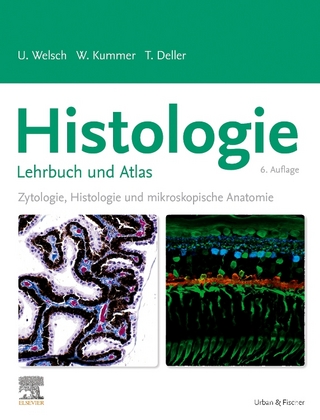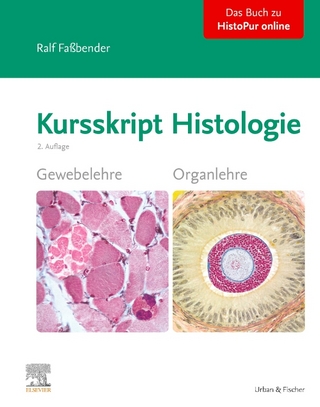
Circulating Tumor Cells
John Wiley & Sons Inc (Verlag)
978-1-118-91553-0 (ISBN)
- Titel z.Zt. nicht lieferbar
- Versandkostenfrei innerhalb Deutschlands
- Auch auf Rechnung
- Verfügbarkeit in der Filiale vor Ort prüfen
- Artikel merken
Presents the historical perspective and the overview of the field of circulating tumor cells (CTCs)
Discusses the state-of-art methods for CTC isolation, ranging from the macro- to micro-scale, from positive concentration to negative depletion, and from biological-property-enabled to physical-property-based approaches
Details commercially available CTC platforms
Describes post-isolation analysis and clinical translation
Provides a glossary of scientific terms related to CTCs
Z. Hugh Fan, PhD, is a professor of the Department of Mechanical and Aerospace Engineering, J. Crayton Pruitt Family Department of Biomedical Engineering, and Department of Chemistry at the University of Florida (UF), USA. Prior to joining UF in 2003, Dr. Fan was a Principal Scientist at ACLARA BioSciences Inc. and was previously a Member of the Technical Staff at Sarnoff Corp. Dr. Fan has been recognized with E.T.S. Walton Award from Science Foundation of Ireland in 2009, Fraunhofer-Bessel Research Award from Alexander von Humboldt Foundation (Germany) in 2010, and UF Research Foundation Professorship in 2014.
List of Contributors xv
Foreword xxi
Preface xxv
PART I INTRODUCTION 1
1 Circulating Tumor Cells and Historic Perspectives 3
Jonathan W. Uhr
1.1 Early Studies on Cancer Dormancy Led to the Development of a Sensitive Assay for CTCs (1970–1998) 3
1.2 Modern Era for Counting CTCs: 1998–2007 6
1.3 Proof of Malignancy of CTCs 7
1.4 New Experiments Involving CTCs 7
1.5 Clinical Cancer Dormancy 8
1.6 Human Epidermal Growth Factor Receptor 2 (HER2) Gene Amplification can be Acquired as Breast Cancer Progresses 10
1.7 uPAR and HER2 Co-amplification 11
1.8 Epithelial–Mesenchymal Transition (EMT) 12
1.9 New Instruments to Capture CTCs 14
1.10 Genotypic Analyses 15
1.11 Conclusions 18
References 20
2 Introduction to Microfluidics 33
Kangfu Chen and Z. Hugh Fan
2.1 Introduction 33
2.2 Scaling Law 36
2.3 Device Fabrication 39
2.4 Functional Components in Microfluidic Devices 43
2.5 Concluding Remarks 46
References 47
PART II ISOLATION METHODS 51
3 Ensemble-decision Aliquot Ranking (eDAR) for CTC Isolation and Analysis 53
Mengxia Zhao, Perry G. Schiro, and Daniel T. Chiu
3.1 Overview of eDAR 53
3.2 Individual Components and Analytical Performance of eDAR 55
3.3 Application and Downstream Analyses of eDAR 69
3.4 Conclusion and Perspective 80
References 81
4 Sinusoidal Microchannels with High Aspect Ratios for CTC Selection and Analysis 85
Joshua M. Jackson, Małgorzata A. Witek, and Steven A. Soper
4.1 Introduction 85
4.2 Parallel Arrays of High-Aspect-Ratio, Sinusoidal Microchannels for CTC Selection 90
4.3 Clinical Applications of Sinusoidal CTC Microchip 114
4.4 Conclusion 118
Acknowledgments 119
References 119
5 Cell Separation using Inertial Microfluidics 127
Nivedita Nivedita and Ian Papautsky
5.1 Introduction 127
5.2 Device Fabrication and System Setup 128
5.3 Inertial Focusing in Microfluidics 129
5.4 Cancer Cell Separation in Straight Microchannels 132
5.5 Cancer Cell Separation in Spiral Microchannels 136
5.6 Conclusions 142
References 142
6 Morphological Characteristics of CTCs and the Potential for Deformability-Based Separation 147
Simon P. Duffy and Hongshen Ma
6.1 Introduction 147
6.2 Limitations of Antibody-based CTC Separation Methods 148
6.3 Morphological and Biophysical Differences Between CTCs and Hematological Cells 149
6.4 Historical and Recent Methods in CTC Separation Based on Biophysical Properties 153
6.5 Microfluidic Ratchet for Deformability-Based Separation of CTCs 155
6.6 Resettable Cell Trap for Deformability-based Separation of CTCs 160
6.7 Summary 165
References 166
7 Microfabricated Filter Membranes for Capture and Characterization of Circulating Tumor Cells (CTCs) 173
Zheng Ao, Richard J. Cote, Ram H. Datar, and Anthony Williams
7.1 Introduction 173
7.2 Size-based Enrichment of Circulating Tumor Cells 174
7.3 Comparison Between Size-based CTC Isolation and Affinity-based Isolation 177
7.4 Characterization of CTCs Captured by Microfilters 178
7.5 Conclusion 180
References 181
8 Miniaturized Nuclear Magnetic Resonance Platform for Rare Cell Detection and Profiling 183
Sangmoo Jeong, Changwook Min, Huilin Shao, Cesar M. Castro,
Ralph Weissleder, and Hakho Lee
8.1 Introduction 183
8.2 μNMR Technology 184
8.3 Clinical Application of μNMR for CTC Detection and Profiling 191
8.4 Conclusion 196
References 196
9 Nanovelcro Cell-Affinity Assay for Detecting and Characterizing Circulating Tumor Cells 201
Millicent Lin, Anna Fong, Sharon Chen, Yang Zhang, Jie-fu Chen, Paulina Do, Morgan Fong, Shang-Fu Chen, Pauline Yang, An-Jou Liang, Qingyu Li, Min Song, Shuang Hou, and Hsian-Rong Tseng
9.1 Introduction 202
9.2 Proof-of-Concept Demonstration of NanoVelcro Cell-Affinity Substrates 207
9.3 First-Generation NanoVelcro Chips for CTC Enumeration 209
9.4 Second-Generation NanoVelcro-LMD Technology for Single CTC Isolation 214
9.5 Third-Generation Thermoresponsive NanoVelcro Chips 219
9.6 Conclusions and Future Perspectives 220
Acknowledgment 221
References 221
10 Acoustophoresis in Tumor Cell Enrichment 227
Per Augustsson, Cecilia Magnusson, Hans Lilja, and Thomas Laurell
10.1 Introduction 227
10.2 Factors Determining Acoustophoresis Cell Separation 230
10.3 Acoustophoresis System for Separating Cells 234
10.4 Acoustophoresis Platform for Clinical Sample Processing 239
10.5 Unperturbed Cell Survival and Phenotype after Microchip Acoustophoresis 244
10.6 Summary 246
References 246
11 Photoacoustic Flow Cytometry for Detection and Capture of Circulating Melanoma Cells 249
John A. Viator, Benjamin S. Goldschmidt, Kiran Bhattacharyya, and Kyle Rood
11.1 Introduction 249
11.2 Current Methods for Detection and Capture of CMCs 254
11.3 Discussion 259
11.4 Future Work 261
References 262
12 Selectin-Mediated Targeting of Circulating Tumor Cells for Isolation and Treatment 267
Jocelyn R. Marshall and Michael R. King
12.1 Introduction 267
12.2 CTC Capture by E-selectin 271
12.3 Applications for E-selectin in Cancer Diagnosis and Treatment 273
12.4 Conclusions 278
References 279
13 Aptamer-Enabled Tumor Cell Isolation 287
Jinling Zhang and Z. Hugh Fan
13.1 Introduction 287
13.2 Aptamers and their Biomedical Applications 288
13.3 Aptamer-based Tumor Cell Isolation 290
13.4 Conclusion and Outlook 297
References 297
14 Depletion of Normal Cells for CTC Enrichment 301
Jeffrey J. Chalmers, Maryam B. Lustberg, Clayton Deighan, Kyoung-Joo Jenny Park, Yongqi Wu, and Peter Amaya
14.1 Introduction 301
14.2 Estimates of Number and Type of Cells in Blood 302
14.3 Summary of Examples of Negative Depletion 303
14.4 Types of Cells Observed After Depletion of Normal Cells 305
14.5 Incomplete Depletion of Normal Cells 305
14.6 Conclusion 310
References 311
PART III POST-ISOLATION ANALYSIS AND CLINICAL TRANSLATION 313
15 Tumor Heterogeneity and Single-cell Analysis of CTCs 315
Evelyn K. Sigal and Stefanie S. Jeffrey
15.1 Introduction 315
15.2 Tumor Heterogeneity 316
15.3 Single-Cell Analysis of CTCs and CTC Heterogeneity 318
15.4 Gene Expression Analysis 319
15.5 Mutational Analysis 321
15.6 Conclusion: Clinical Implications and Future Perspectives 323
References 324
16 Single-Cell Molecular Profiles and Biophysical Assessment of Circulating Tumor Cells 329
Devalingam Mahalingam, Pawel Osmulski, Chiou-Miin Wang, Aaron M. Horning, Anna D. Louie, Chun-Lin Lin, Maria E. Gaczynska, and Chun-Liang Chen
16.1 Introduction 329
16.2 Methods 331
16.3 CTC Applications 336
16.4 Conclusions 342
References 343
17 Directing Circulating Tumor Cell Technologies Into Clinical Practice 351
Benjamin P. Casavant, David Kosoff, and Joshua M. Lang
17.1 Introduction 351
17.2 Defining Biomarkers 352
17.3 The Technology 356
17.4 Translating Technology 357
17.5 Conclusions 360
References 361
PART IV COMMERCIALIZATION 365
18 DEPArray™ Technology for Single CTC Analysis 367
Farideh Z. Bischoff, Gianni Medoro, and Nicolo Manaresi
18.1 Challenges in Molecular Profiling of CTCs 367
18.2 DEPArray™ Technology Solution 368
18.3 DEPArray™ for Single Tumor Cell Analysis 369
18.4 Clinical Significance in Single CTC Profiling 373
18.5 Conclusion 374
References 374
19 CELLSEARCH® Instrument, Features, and Usage 377
Denis A. Smirnov, Brad W. Foulk, Mark C. Connelly, and Robert T. McCormack
19.1 Introduction 377
19.2 Principles of CELLSEARCH® 379
19.3 EpCAM Density and CTC Capture 380
19.4 Clinical Applications of CELLSEARCH® CTCs 383
19.5 Beyond EpCAM Capture 390
19.6 Discussion 391
References 394
PART V GLOSSARY 401
Circulating Tumor Cell Glossary 403
Jose I. Varillas and Z. Hugh Fan
Index 423
| Erscheinungsdatum | 14.05.2016 |
|---|---|
| Reihe/Serie | Chemical Analysis: A Series of Monographs on Analytical Chemistry and Its Applications |
| Mitarbeit |
Herausgeber (Serie): Mark F. Vitha |
| Verlagsort | New York |
| Sprache | englisch |
| Maße | 163 x 244 mm |
| Gewicht | 794 g |
| Themenwelt | Medizin / Pharmazie ► Medizinische Fachgebiete ► Onkologie |
| Studium ► 1. Studienabschnitt (Vorklinik) ► Histologie / Embryologie | |
| Naturwissenschaften ► Biologie | |
| Naturwissenschaften ► Chemie | |
| Technik ► Umwelttechnik / Biotechnologie | |
| ISBN-10 | 1-118-91553-4 / 1118915534 |
| ISBN-13 | 978-1-118-91553-0 / 9781118915530 |
| Zustand | Neuware |
| Haben Sie eine Frage zum Produkt? |
aus dem Bereich


